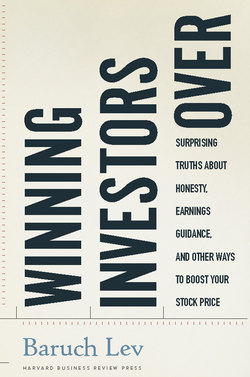Читать книгу Winning Investors Over - Baruch Lev - Страница 25
На сайте Литреса книга снята с продажи.
Operating Instructions
ОглавлениеI opened this chapter with a dysfunctional conference call, long on rosy assertions, short on details, and mum on forward-looking guidance. In contrast, TCF Financial, a bank, held a conference call on January 15, 2004, that also followed a disappointing quarter and year—decreasing earnings and missing the consensus estimate—yet its stock price increased during the call by about 2 percent. What gives?
TCF's call opened with the CEO's brief, matter-of-fact presentation providing a clear outline of the causes of the earnings shortfall (primarily low interest rates, causing enhanced loan prepayments) and proceeding with specific curative plans for next year (such as opening twenty-four branches). No fluff, no empty reassurances. Giving truth to sharing the pain, TCF's CEO announced during the call that since the 2003 earnings goal was missed, “TCF management will not be receiving incentive compensation this year.” How refreshing. Furthermore, the CEO set a tough earnings goal for incentive compensation for 2004: $3.70 EPS versus the disappointing $3.05 EPS in 2003. The answers to analysts' questions during the call were equally informative, quantitative, and, more important, forward looking. To a question about debit card revenue next year, the answer was, “net debit card revenues will increase next year by approximately 10 percent”—a verifiable target, enhancing managers' credibility. Regarding the outlook of the bank's leasing equipment business, the important forward-looking indicator of a leasing backlog of $187 million at the end of 2003 was given. A question about the 2004 tax rate triggered a terse “34.25ish” answer.45 No wonder that investors were pleased with TCF's conference call, and analysts are likely to participate in subsequent calls.
My specific operating instructions for managers' communications are:
HARDEN SOFT INFORMATION. When possible, replace or augment narrative with numbers that are comparable across companies and computed the same way by your competitors, like earnings or order backlog. The numbers should be verifiable and audited, or aligned with subsequent facts. For example, TCF's CEO succinctly quantified the major reason for the disappointing year thus: “Big impact for the year for us was the 44 million dollars that we spent in debt cancellation, mostly in the third quarter, which impacted on an after-tax basis about 41 cents per share for the year.”46 Not exactly Shakespearean, yet straight to the point.
PAY ATTENTION TO TONE AND STYLE. Most managers focus on the subject matter of the communication, or what the message is, and leave to an afterthought its tone and style, how it is communicated. The evidence is unanimous: tone and style—pessimism or optimism, certain or wavering, crisp or foggy—count in changing investors' perceptions and their actions. In particular, frankness enhances credibility.47 Here is Warren Buffett in a 2007 shareholder letter discussing a table showing that Berkshire's pretax EPS rose from 1965 to 2007 from $4 to an astounding $4,093: “Berkshire's past record can't be duplicated or even approached. Our base of assets and earnings is now far too large for us to make outsized gains in the future.” (p. 4) Typical no-hype Warren.
FOSTER INTERACTIVE COMMUNICATION. I documented earlier that the effectiveness of conference calls increases with the number of participants and the number of questions asked. It's important, therefore, to engage analysts and investors as much as possible in interactive discussion. Ex cathedra preaching is better left to the clergy.
ENHANCE COMPANY RECOGNITION (VISIBILITY). Investors' limited attention adversely affects their demand for small and mid-cap companies' shares and lowers their prices. Effective investor relations and positive media exposure mitigate investors' limited attention, positively affecting IPOs' outcomes and companies' capitalization.48 Feed the business press interesting stories about exciting products and business ventures; don't be coy about important social responsibility initiatives; and turn the usually dull shareholder meetings into media events.
AND, YES, LIGHTEN UP. The somber, sometimes grim atmosphere of investor communications is contagious and counterproductive; lighten up the discussion. Here are several vignettes from Warren Buffett's 2007 letter to shareholders:
John Stumpf, CEO of Wells Fargo, aptly dissected the recent behavior of many lenders: “It is interesting that the industry has invented new ways to lose money when the old ways seemed to work just fine.” (p. 3)
A footnote: We paid the IRS tax of $1.2 billion on our PetroChina gain. This sum paid all costs of the U.S. government—defense, social security, you name it—for about four hours. (p. 16)
(I've reluctantly discarded the notion of my continuing to manage the portfolio after my death—abandoning my hope to give new meaning to the term “thinking outside the box.”) (p. 18)
But note, no humor is better than lame humor (this writer exempted).
AND, DON'T PLAY GAMES. Angela Davis and Isho Tama-Sweet examined fourteen thousand quarterly earnings releases and report that managers' pessimistic tone in the widely watched preliminary earnings release, concerning declining earnings or missing analysts' estimates, was substantially tamer than their pessimistic tone in the subsequent, less followed management discussion and analysis (MD&A) section in the financial report.49 Obviously, managers tried to soften the blow in the earnings release and protect themselves against litigation in the subsequent MD&A. Shareholders generally wise up to such games, and when they do, your integrity is seriously hurt.
